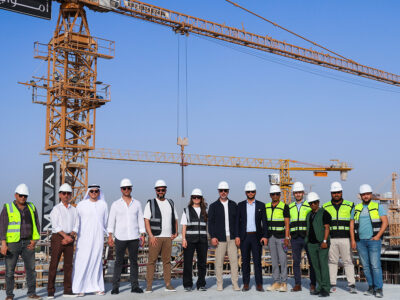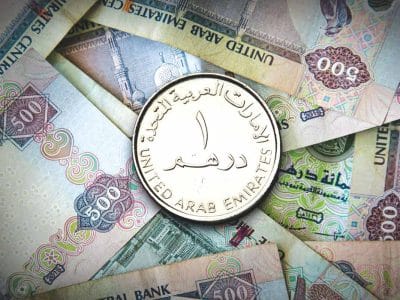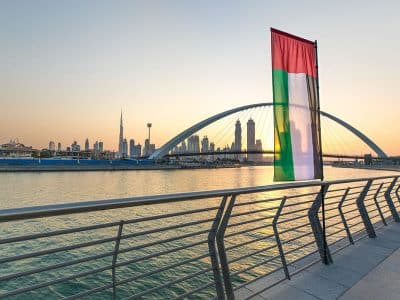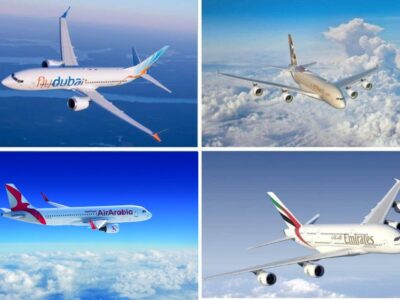Abu Dhabi is cashing in on the region’s golf passion by building a course on Saadiyat Island.
For a man who has just announced that he’s about to invest a cool US$11m in local property development, Lee Tabler is remarkably calm.
The occasion was the launch of the Saadiyat Island Beach Golf Course by the Tourism Development and Investment Company (TDIC) which manages the Abu Dhabi government’s real estate assets.
The star of the show was South African golfing legend turned golf course designer Gary Player who designed the Saddiyat Island course.
But US born Tabler was the man chosen by HH Sheikh Mohammed bin Zayed Al Nahyan and Abu Dhabi Tourism Authority director general Mubarak Al Muhairi two and a half years ago to create a private company that would step up development of tourism in the UAE capital while maintaining and cherishing Abu Dhabi’s commitment to caring for the environment and its rich array of natural resources.
Tabler is now CEO of TDIC, an independent public joint stock company of which Abu Dhabi Tourism Authority (ADTA) is the sole shareholder.
While the glitzier Dubai, just an hour’s drive away, is pushing ahead at a rate of knots and building on every available piece of ground, Abu Dhabi is content to move at a slower and more considered pace.
The golf course deal is a typical example and although sub developers are itching to pour an estimated US$16.3bn into the area, the TDIC has laid down very definite ground rules, as Tabler explains.
“Abu Dhabi has deliberately taken a slower route than Dubai. There is a wish to keep Abu Dhabi conservative and environmentally friendly and not very urban.”
TDIC is owned by the government but it is a private company. We have our own policies.
Our job is to help develop the vision of Abu Dhabi taking advantage of the natural treasures, the beautiful mountains, the mangrove forests and beaches.
“In addition the emirate enjoys tremendous sea life. There are 200 natural islands and tremendous marine resources and wonderful bird life. We don’t disturb these but take advantage of them.”
“We also have a pre-Islamic Christian settlement and Islamic heritage sites and a paleontological site where the remains of dinosaurs have been excavated.”
“We are creating hotels, golf courses and attractions that will embrace these natural assets,” he says.
Gary Player’s company was chosen partly because of its admirably ‘green’ track record. Saadiyat Island Beach will be his only signature course in the UAE and the Arabian Gulf’s first ocean course.
The Par 72 course will be built in the upmarket beach district of Saadiyat Island, the 27 sq km island lying 500 meters offshore from the UAE capital, and will be unique in the region in having several beachfront holes.
The course will have sweeping Gulf and beach views and is due for completion next year.
Eco-guidelines for the course include a protection zone for a nearby section of beach which is a hatching spot for Hawksbill turtles and sand dune protection guidelines to be implemented by course management.
On an early site visit Tabler observed both turtles and dolphins in their natural habitat and determined that there would not be a line of high-rise hotels and apartments disturbing their peace.
Hotel developers have been chosen carefully and their designs will be expected to keep eco-principles as a priority and blend in with both the beach and the golf course.
TDIC has chosen a limited number of select developers for beach projects and a series of five-star luxury waterfront resorts have been approved.
TDIC has laid down strict guidlines for the resorts which have a series of natural dunes and fauna lying directly behind their beachfronts.
The amphitheatre-style course will be capable of hosting a major tournament in the future.
It has been designed in a classic figure of eight configuration with over a third of the course having views of the coastline.
It will snake in and out of nine hotels which will front the course, exposing open tees to the waterfront.
There will be two freshwater lakes and one saltwater lake.
Landscaping and course garden areas will utilise native grasses and desert palms.
Bermuda grass is to be used as the primary turf for the fairways, greens and tees, while drought tolerant Bahai turf has been selected for the outer rough and fairway peripheries as it uses a third less water than Bermuda.
Tabler, an occasional golfer himself, is very aware of golf’s potential as a driver of investment in property.
“It’s been proven around the world as a tremendous asset for any country.”
A lot of people watch golf and see the lovely courses on television. His Highness decided to bring the Abu Dhabi Golf Championships here in order to attract tourism opportunities.
We’re in the process of redesigning the Abu Dhabi course, adding a hotel and new homes and villas, townhouses and apartments and really creating a community around the golf course. Golf communities are sought-after all over the world.
“Real estate values achieve a premium as a result of being on a golf course. We look forward to having a second world-class course here. It will be spectacular.”
“There’s no landfill here. It’s all natural dune grasses.”
The land has been graded and the first hole has already been shaped and it is expected that the first round will be played in October 2010 with several hotels being completed the preceding year. Selling of residential units will begin some time at the end of the first quarter of 2008.
Tabler says he hopes new laws will be passed soon to facilitate more purchases of the properties by foreign buyers.
“There has been a lot of interest in Abu Dhabi properties which at present are only on sale to nationals, although foreigners can purchase on a long lease,” says Tabler.
“Discussions have been had for federal laws to be passed. It has been discussed very seriously and it is likely to happen although I can’t say when. The leaders of this country are looking forward to foreign investment in Abu Dhabi.”
“At present TDIC is primarily selling to Abu Dhabi residents. Our leases and joint ventures have only taken place with Abu Dhabi.”
The total cost of developing Saadiyat Island, which translates from Arabic as Island of Happiness, is estimated at around US$27.2bn.
Since the formation of TDIC, the company which launched with an initial paid-up capital of US$28m, has poured US$2bn into the island including the golf course and hotels and several other projects including the much talked about cultural district.
At least US$1.36bn of that has gone towards building the island’s infrastructure. Another golf course is planned and 5,000 residential units are to be built in the first phase of the development.
Four museums are also proposed, including a Louvre and a Guggenheim, models of which can be viewed in an exhibition at the Emirates Palace hotel.
Says Tabler: “We negotiated with the Louvre in Paris. It’s the first time the world-renowned museum has been developed outside France. We have an agreement with the French Museums Agency that 130 cultural museums from France will be lending art.”
“As the Abu Dhabi collections ramp up, the loans will ramp down.”
“Ten years ago the Guggenheim in Bilbao opened. The third and largest Guggenheim will be in Abu Dhabi.”
“That will attract cultural tourism. It exposes a broader audience and also the population here to art and education associated with art and culture.”
“Some of the projects are already under construction, some are in the planning phase, while some will soon to be under construction.”
Other planned attractions are the Sheikh Zayed National Museum, a performing arts centre designed by Zaha Hadid and a maritime museum by Japan’s Tadao Ando.
TDIC is also behind the unique Desert Islands project, one of the world’s largest sustainable island tourism destinations currently under development.
Saadiyat Island, occupying 27 sq km to the north east of Abu Dhabi city, is TDIC’s flagship development and has already been mentioned as one of the world’s top 10 trendiest tourism destinations of the future by the Wall Street Journal.
The entire project is due for completion by 2018 and an estimated 150,000 people will make it their home. It will be linked to the city by two causeways, one of which will operate a light rail system and a 10-km long highway with a bridge.
Eventually Saadiyat Island will be made up of seven distinctive districts – Cultural District, Saadiyat Business Marina, Saadiyat Beach, South Beach, Saadiyat Park, the Wetlands and Ecopoint.
There will be 29 hotels – including one seven-star hotel, and three marinas with moorings for 1,000 yachts.
Tabler is confident that investors will come running to the development, especially if new federal laws are passed allowing foreigners to own freehold property.
However he says he is in no hurry and just wants to get the whole package right before allowing the investment capital to flood in: “We are not aggressive in sales, that’s why we are creating museums and golf courses.”
Although his professional golfing days are over, his passion for golf course design has made him as successful a businessman as he was a sportsman.
He says quite simply: “You couldn’t pick a better spot than this to design a golf course in the desert and on the beach.”
“This is a country that I have fallen in love with for many reasons. There is so much on offer. We are putting in a very special effort to put in something very special.”
Like many golf course designers he is particularly concerned about water supplies in the future. “On my farm in South Africa water is a critical issue as it will be in the GCC of the future.”
“The majority of the world doesn’t have the amounts of water that they think they have. We have incorporated all these things into our course designs.”
“Water management is the number one issue for successful golf course maintenance and conditioning.”
“This course will have a modern, computer-controlled irrigation system which allows for flexibility to ensure sound irrigation practices are utilised and the dispensing of adequate water to guarantee optimum plant growth while avoiding over-irrigation.”
“At heart I’m an environmentalist. I’m a farmer and we have great respect for water and land. We have not been greedy and have not tried to cover the land with buildings.”
“We wanted to design some holes on the beach so that golfers would have that walking on the beach experience.”
“There is more than just developing a golf course. It’s contributing in more ways than one. I love taking golf to nature – with a putting surface 15 feet from the beach.”
“It’s got to be a gift to nature, something that inspires the soul.”
“I want to encourage the young people of this country to experience the game and take it up. Golf is such a great thing in life.”
“It teaches you to be patient and to have respect. I have been doing this for 55 years and one of the things that is lacking in this world is respect for other people’s cultures”.
The Saadiyat Beach Golf Course comes under the jurisdiction of an overarching water strategy mapped out for the island. Initially, the daily course requirement of one million US gallons of irrigation water will come from desalination plants being procured by TDIC but as the island’s population grows, irrigation water will come from sewage treatment works.







